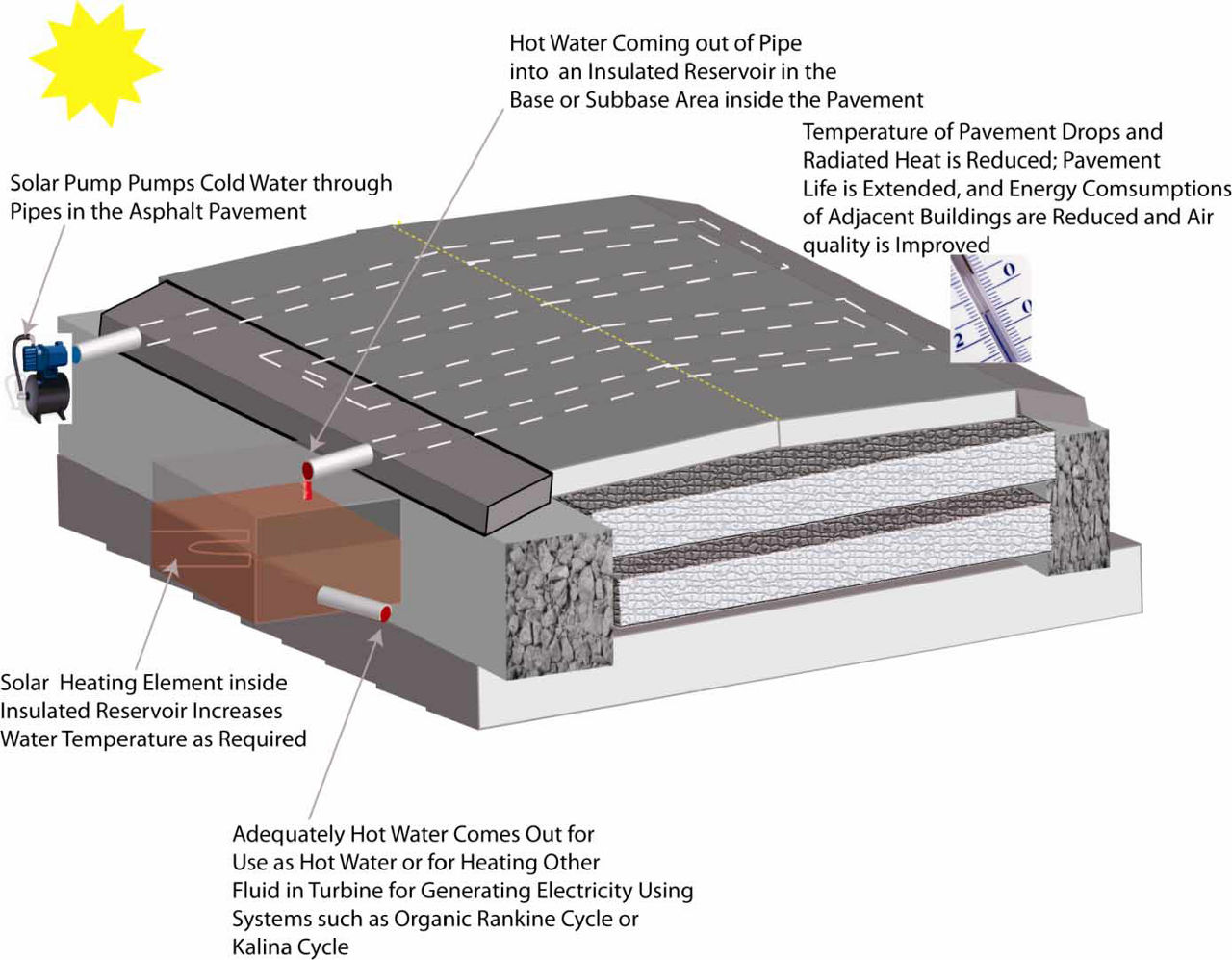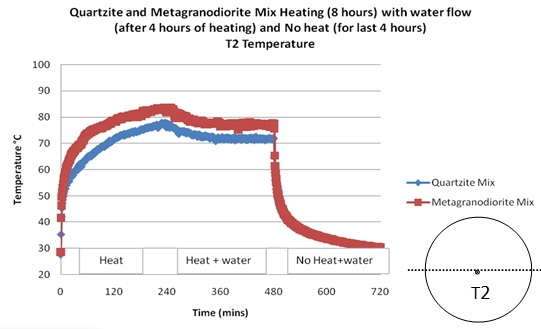Asphalt Pavement Solar Collectors: The Future is Now
For several years universities in the United States have been looking into the feasibility of using asphalt pavement to collect solar energy, or, more correctly, to harvest the solar energy that asphalt pavement is already collecting. Researchers have found that the technology exists for harvesting this energy, and its implementation may not be that far off.

“There is no doubt in my mind it [asphalt pavement that harvests solar energy] will become regular and routine,” says Dr. Rajib Mallick, professor of civil engineering at Worcester Polytechnic Institute (WPI) in Worcester, Massachusetts. “Our past research has demonstrated how much energy can be withdrawn in certain circumstances. Now we have to demonstrate to potential users that modifying their existing facilities – or incorporating it into new facilities or retrofits – makes sense economically.”
The Original Concept
The original concept behind asphalt pavement solar collectors was to embed pipes in asphalt pavement below the wearing course that would contain water or another circulating fluid. If someone nearby – such as occupants of a residence, hotel, office, or similar facility – needed hot water, the water from the embedded pipes could be used directly, perhaps to reduce the energy requirement to heat colder water to a desired temperature. In cold weather, the hot water could be used directly for building heat. If no one nearby needed hot water, the heat could be used to generate electricity.

“We simply wanted to take advantage of what was already occurring,” says Mallick. “Asphalt heats up in the sun. Why not extract that heat and use it?” However, pursuit of this technology had an additional motive. “Long experience has shown that asphalt that gets too hot deteriorates. It is subject to rutting. If we remove heat from the pavement, not only can we recover solar energy, but we should also be able to extend the life of the pavement,” Mallick explains. If the hot water in the embedded pipes cannot be used directly, the efficiency of the system is reduced. “Generating electricity from organic fluids that vaporize for electrical generation doesn’t convert the solar energy as efficiently to beneficial use,” Mallick says.
Beyond the Original Concept
At the University of Rhode Island (URI), Dr. K. Wayne Lee, professor of civil and environmental engineering, has conducted research similar to Mallick's and is looking beyond the original concept. “More can be done to extract energy from roads,” says Lee. “URI is looking at four ways to accomplish this.” Direct heat extraction from the pavement is the first. As indicated by both the URI and WPI research, direct heat extraction is readily achievable in the short term. A second approach is to bury semiconductors at different depths in sections of pavement and develop a heat differential across them that can be used to generate electricity, which is known as the Seebeck effect. Enough semiconductors can result in enough electricity for beneficial use.
“Our past research has demonstrated how much energy can be withdrawn in certain circumstances. Now we have to demonstrate to potential users that modifying their existing facilities – or incorporating it into new facilities or retrofits – makes sense economically.” Dr. Rajib Mallick, Worcester Polytechnic Institute
A third method being investigated by Lee is to drape a flexible solar collector over the Jersey barriers that are used so often on eastern U.S. highways. “Solar panels used to be made of rigid materials or frames,” says Lee. “The technology has advanced to where now we have fabrics that are solar collectors. Cover the Jersey barriers with them for a long stretch of highway and you can generate enough electricity to power the highway lighting and signage.”
The fourth method is to replace the asphalt or concrete pavement with a multi-layered system consisting of an electronic layer between base solar collectors and wearing courses. The wearing course would be transparent, allowing sunlight to penetrate to the collecting layer. The electronic core takes its power from the sun and can be used to flash messages to motorists, replacing signs and markings. “This is much farther in the future,” says Lee, “with the feasibility far from being demonstrated. Still, it’s good to be looking into multiple ways to use the roadway as a source of energy.”
Lee’s work at URI has been enhanced by funding and cooperation from the Korea Institute for Construction Technology and the Korea Expressway Corporation. Some of his work has progressed to the point where experimentation has moved into the Mechanical and Electrical Engineering departments. “It is both an international and a multi-disciplinary enterprise,” Lee says.
Addressing the Problems
Meanwhile, back at WPI, Mallick is about to embark on a new round of research. “Embedded pipes might be fine for parking lots, but not for roads and highways," he says. "What we believe will work better is a geotextile embedded in the pavement, beneath the wearing course. This involves the use of a graphene layer. A specially designed and manufactured geotextile can function as a solar collector as efficiently as the pipes.”


According to Mallick, part of the problem with using asphalt pavement to capture solar energy is demonstrating to potential users that enough energy can be captured in various climatic conditions. In the southern parts of the United States, this shouldn’t be a problem, but in New England, where both Mallick and Lee teach and conduct their research, solar energy as measured by “degree days” and as interrupted by cloud cover and precipitation makes the feasibility of using asphalt pavement to capture solar energy less certain. Mallick will soon be using a National Science Foundation grant to measure the practicality of solar capture by asphalt pavement. A chamber to house a 10’ x 20’ asphalt pavement slab will be used, with sunlight, cloud cover, and precipitation simulated. “This will show energy collection over a broader range of conditions,” Mallick says, “and will hopefully show that these systems can be installed right now and the investment be paid off quickly.”
What’s Next
Some of these methods for capturing solar energy via the roadways, such as an electronic roadway with embedded LED systems, may sound very futuristic. However, some of these methods seem very doable, even right now. Why not use Jersey barriers to hold solar fabric and connect it to energy-extraction hardware? Why not take a portion of a parking lot, which has fairly light traffic loading, and extract some heat from it and use it beneficially?
“Long experience has shown that asphalt that gets too hot deteriorates. It is subject to rutting. If we remove heat from the pavement, not only can we recover solar energy, but we should also be able to extend the life of the pavement.” Dr. Rajib Mallick, Worcester Polytechnic Institute
Forty years ago I studied in the asphalt lab in Bliss Hall in Kingston, Rhode Island, molding those Marshall cylinders and dropping the hammer from the right height the right number of times. Who would have thought that in 2011 Dr. Lee would be using those same facilities to see if nanotechnology could be used to improve the efficiency of collecting and extracting solar power from asphalt pavement? Now it seems the entire roadway is being considered as an asset with functionality beyond traffic and parking. I can envision this research expanding into other areas, showing how the roads can be put to multiple uses. What will that roadway look like 40 years from now?

David A. Todd
A senior engineer and corporate trainer of engineering for CEI Engineering Associates, Inc. David has 36 years of experience as a consulting civil engineer. His experience includes water, wastewater, stormwater, roads, and solid waste infrastructure. For much of the last 20 years he has been involved with stormwater issues. Specifications and construction administration have been a specialty of his within civil consulting engineering . He has BS and MS degrees in Civil Engineering, is a registered engineer in four states, and a Certified Professional in Erosion and Sediment Control.

